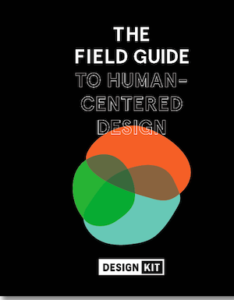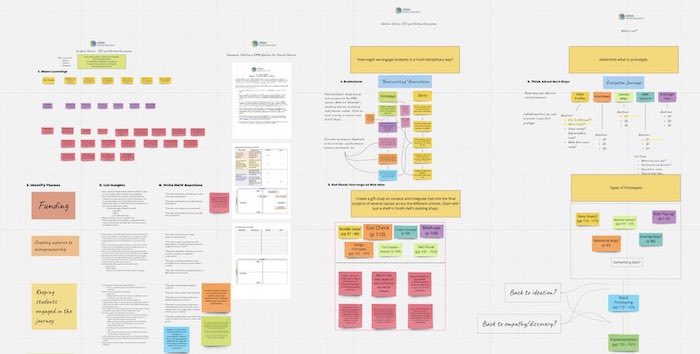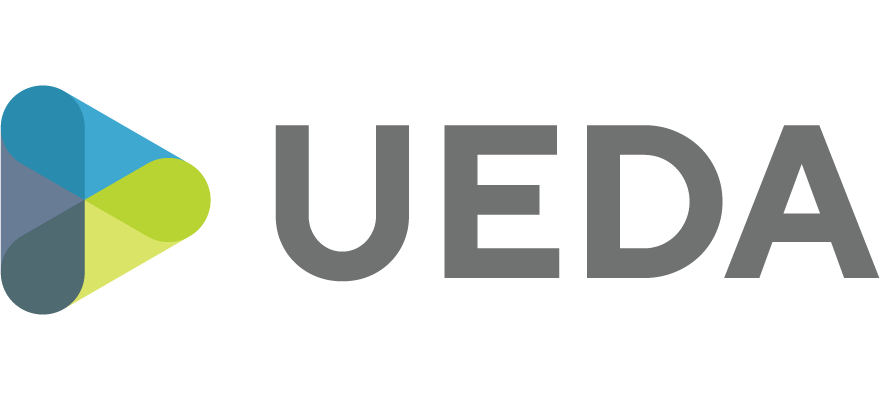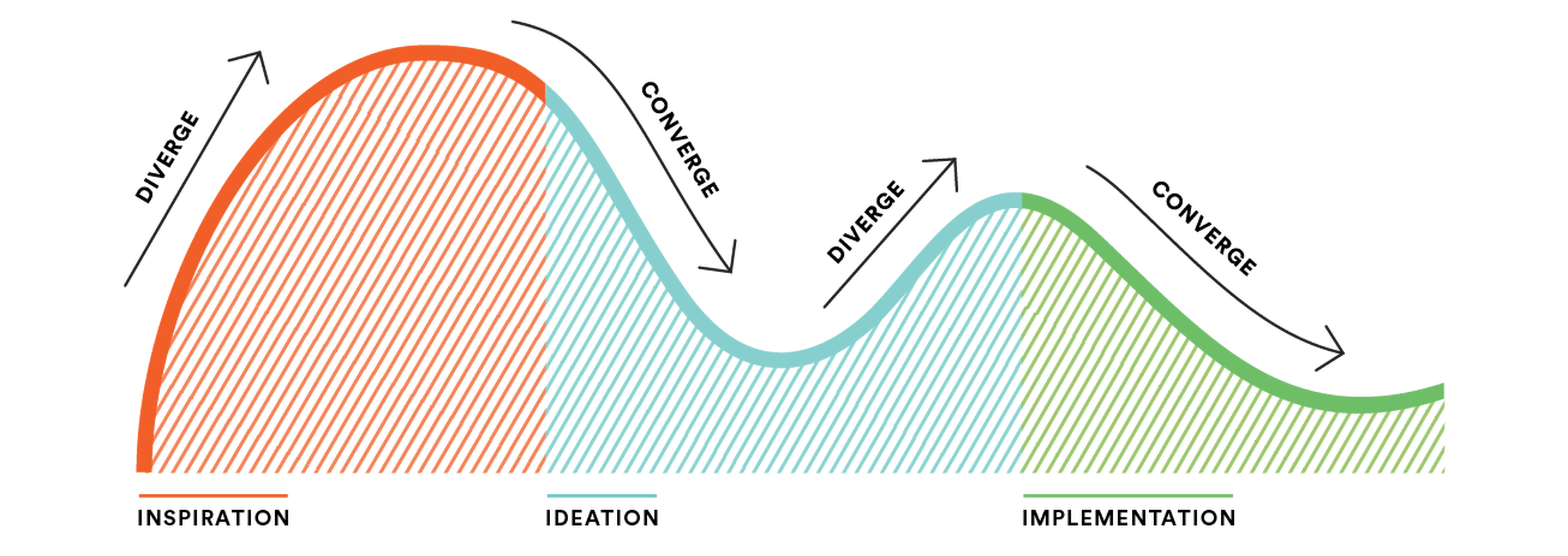Day One’s Insight Session granted UEDA Ecosystems Design Network (EDN) members the opportunity to synthesize interviews with regional and community stakeholders, thematically organize the central challenges facing their ecosystem, and develop questions to generate possible solutions and feasible next steps. Throughout the workshop, participants benefited from idea-sharing activities across ten distinct ecosystems and among over 120 related partners, enjoying dynamic interaction via Zoom and Miro software. With facilitation from UEDA, ecosystem members oscillated between curated and informative “main room” sessions and “breakout rooms,” where Miro was used to compile and organize ecosystem-specific ideas, observations, and questions onto a permanently accessible and adaptable digital board. Along the way, UEDA members were encouraged to ask questions of UEDA’s EDN Steering Committee, access posted resources, and share their own session-by-session observations with the broader UEDA network.
Insight Session Overview & Embracing Human-Centered Design
 After welcoming all UEDA Ecosystems Design Network members, UEDA Vice President, Jim Woodell, referenced The Field Guide to Human-Centered Design as a touchstone resource for UEDA ecosystem participants. Woodell emphasized that the distinct stages of inspiration, ideation, and implementation rarely form a “linear path.” Instead, he argued, they are part of an ongoing iterative process in which perceived failures or missteps represent opportunities to refine, modify, or compress the scope of a project to achieve clear, measurable goals with higher effectiveness. Reiterating the human-centered design values of optimism, empathy, and embracing ambiguity, Woodell encouraged UEDA EDN members to use the day’s session to share learnings, locate themes, ask generative questions, and catalog the full range of possible solutions and adaptations to the challenges identified by each ecosystem.
After welcoming all UEDA Ecosystems Design Network members, UEDA Vice President, Jim Woodell, referenced The Field Guide to Human-Centered Design as a touchstone resource for UEDA ecosystem participants. Woodell emphasized that the distinct stages of inspiration, ideation, and implementation rarely form a “linear path.” Instead, he argued, they are part of an ongoing iterative process in which perceived failures or missteps represent opportunities to refine, modify, or compress the scope of a project to achieve clear, measurable goals with higher effectiveness. Reiterating the human-centered design values of optimism, empathy, and embracing ambiguity, Woodell encouraged UEDA EDN members to use the day’s session to share learnings, locate themes, ask generative questions, and catalog the full range of possible solutions and adaptations to the challenges identified by each ecosystem.
Sharing Learnings
During the “Share Learnings” breakout session, members of one UEDA ecosystem listed key takeaways from their interviews with regional and community stakeholders (their “homework” from a prior network session). Participants highlighted that multiple interviewees stressed the need for improved workforce collaboration, including the training of “digitally savvy” employees who operate within supply chains that incorporate AI, censors, and other exponential technologies. Other interviewees voiced the need to provide equitable learning environments for underserved populations, including outreach with first-generation college students, the formerly incarcerated, and middle and high school students seeking viable career paths.
Elsewhere, ecosystem members discussed the need to engage students in a broad, authentic, and appealing way to cultivate peer recommendations and improve rapport among university staff, professors, students, and invested alumni. With the aim of extending the ecosystem’s influence beyond a university environment, participants argued that building and sustaining regular relationships with community organizations and volunteers is equally essential to becoming a welcomed and trusted presence in the region.
One noteworthy point of consensus across multiple ecosystems was the desire to employ a common and comprehensible vocabulary to share ecosystem aspirations, activities, and resources with the general public. Recognizing that the language of economic development is an argot of its own, participants agreed that stakeholders and ecosystem design members must find ways to articulate the ecosystem’s regionally beneficial aims in a way that is interpretable and compelling to the public and to those who might play a role in its promotion and advancement.

Finding Themes
Transitioning to the “Find Themes” portion of the workshop, Woodell highlighted that “the point of identifying themes is to turn challenges into design questions,” and to locate patterns that synthesize learnings into a set of core ecosystem challenges.
In a new set of breakout rooms, multiple ecosystems successfully organized their “Shared Learnings” into a set of 4-6 themes, each showcasing regionally unique characteristics as well as more common challenges. Multiple ecosystems emphasized the principles of Inclusion, Access, and Talent Development among workforces and underserved populations. While considering broad ecosystem aims, one ecosystem addressed the issue of “Silos” and the need to foster collaboration across domains, industries, and locales. The ecosystem’s role in increasing awareness of shared regional resources and assets capable of assisting with regionally valuable initiatives was also discussed. Echoing earlier sentiments regarding the need for clear and shared language surrounding ecosystem aspirations, multiple ecosystems prioritized effective Communications Strategies, particularly in the interests of publicly sharing “success stories” that elevate local gains or innovations into regional wins that can be broadly celebrated and motivate ecosystem participation.
Insight Statements
UEDA Ecosystems Design Network
Focused on knowledge, programming, best practices, and regional collaboration- Join now.
Following this theme-oriented session, Woodell offered a generative prompt to each ecosystem: to create 1-3 insight statements of 15-20 words for each theme, each designed to pinpoint a real or potential problem area that poses a challenge to ecosystem development. Woodell stressed that insight statements are not designed to create a single definitive solution, but to allow participants to reflect on which insights will be most useful in addressing broader ecosystem design challenges.
During the subsequent breakout session, many ecosystems developed statements beginning with affirmative/modal phrases like “We need,” “We must,” “We should,” eventually formulating statements intended to drive design decisions. For example: “We need to create a comprehensive regional inventory of economic development, entrepreneurial, and statewide agencies in the region.” Within most ecosystem discussions and Miro activities, participants capitalized on their efforts in the “Find Themes” segment of the webinar to create insight statements that resonated with fellow ecosystem members, creating a shared perception of top ecosystem priorities. As a result of this successful and incremental progress between sessions, most ecosystems used the remainder of the Insight Statements session to begin brainstorming for “How Might We…?” questions in the next phase of the workshop.
HMW Questions
After each ecosystem developed a set of Insight Statements, attendees were invited to formulate “How might we?” questions, using their insight statements as foundational material. HMW questions, Woodell urged attendees, should avoid embedding a “predetermined solution”; instead, they should invite a variety of possible solutions and even new ideas that inspire further, deeper deliberation. With this approach in mind, Woodell reiterated earlier remarks regarding the non-linear and iterative nature of human-centered design, assuring participants that focus on discussion, consideration, and entertaining a range of potential approaches, is most productive in the “Insights” stage.
In the course of HMW breakout groups, ecosystems generated a wide number of network- and community-building questions like “How might we create links for students to connect meaningfully with local entrepreneurs and get recruited to work there?” Others focused on defining roles within an ecosystem to avoid redundancies and to clearly designate responsibilities: “How might we establish operational definitions of ecosystem roles, reflecting multiple perspectives?” In each case, this final round of breakout sessions was used to prepare for the following week’s Ideation Session.
Transitioning to Ideation
Previewing Day Two’s scheduled activities, Woodell shared information regarding workshop “homework,” which asked ecosystems to use their compiled “How might we?” questions to gauge the potential level of “Impact” and “feasibility” attached to resolving HMW questions. Woddell encouraged attendees to determine “which one appears to hold the most promise in terms of potentially being impactful and […] relatively easy to pursue.”
Concluding the session, Woodell thanked all UEDA ecosystem members for their participation in Day One’s Insight Session and asked ecosystems to return for the following week’s Ideation Session with one definitive HMW question they’d like to address in pursuit of actionable solutions. Each UEDA ecosystem left Day’s One session with a robust and comprehensive board of learnings, insights, and distilled questions suited to drive future ecosystem ideation, design, and implementation.
View video testimonials from UEDA Ecosystems members following Day One’s Insight Session for an inside look at the benefits of workshop participation.
Learn more about Day Two’s Ideation session here, including how ecosystem members are now preparing for prototyping and early implementation phases within their ecosystems.
If you’re interested in participating in future sessions or becoming a member of the UEDA Ecosystems Design Network, learn more here, or contact us to register your ecosystem in pursuit of strong, interconnected, and equitable regional development.


